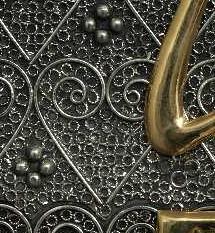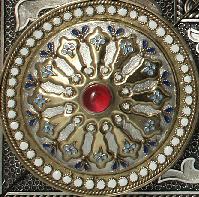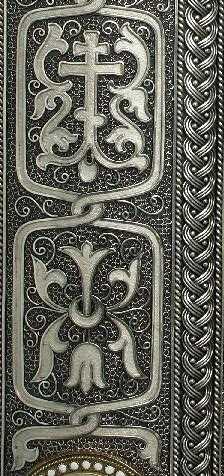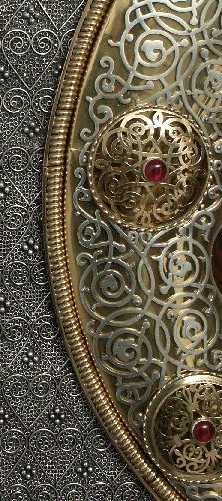| RUSSIAN | ENGLISH | guestbook | contacts |
TO REVIVAL OF FILIGREE TRADITIONS
IN THE ART OF DECORATION
ORTHODOX (CHRISTIAN) ICONS
Tradition to decorate icons with the coating has existed in Rus since before Mongolian period and originates from Oriental Ц Christian traditions of Byzantium. Byzantine silversmiths and goldsmiths achieved high mastery in this art. They were proficient at such the most difficult jewelry techniques as partitive enamel, engraving, filigree. In Russian museums are kept some marvelous samples of the icon coating, real masterpieces of the world jewelry art made by Greek masters, e.g. silver coating of the icon УOur Lady of OdigitriumФ dated end of the 13th century Ц beg. of the 14th century (State Tretyakov Gallery); coating of the icon УOur Lady of OdigitriumФ dated the first third of the 14th century, from Blagovishchensky Cathedral of Moscow Kremlin; coating of the icon УOur Praying LadyФ created between end of the 14th Ц beg. of the 15th century by a Balkan artist and engraver (State Tretyakov Gallery). Among monuments of filigree art there is also kept splendid scan golden coating dated beg. of the 15th century made for the icon of Vladimir Lady by Greek masters to the order of metropolitan Photiy (Chamber of Armament in Moscow Kremlin).
 Development of the art of decorating icons with the coating was
determined for a number of centuries by Byzantine stylistics, ornamental motives
as a rule connected with the Christian traditions as well as by different
specific technologies. Till 15th Ц 16th centuries a variety of pure Russian
motives in jewelry art of Moscow, Novgorod, Pskov and many other cities of
Ancient Rus was formed. Preservation and multiplying of this heritage is
extremely important for revival of cultural and spiritual traditions of the past
especially nowadays.
Development of the art of decorating icons with the coating was
determined for a number of centuries by Byzantine stylistics, ornamental motives
as a rule connected with the Christian traditions as well as by different
specific technologies. Till 15th Ц 16th centuries a variety of pure Russian
motives in jewelry art of Moscow, Novgorod, Pskov and many other cities of
Ancient Rus was formed. Preservation and multiplying of this heritage is
extremely important for revival of cultural and spiritual traditions of the past
especially nowadays.
As the example of such revival there can be mentioned recently
made silver coating for the icon of the St. Great Martyr Panteleymon for Kiev-
Pechersk Lavra. Icon of Athon
characters was given to Kiev- Pechersk Lavra in 2001 in connection with visit to
Kiev of holy head of the St. Great Martyr Panteleymon. Sizes of the icon are as
follows: 123 cm x 89 cm. The coating was made in technique of filigree with
elements of print, open-work filigree, coloring with enamels and decorating with
stones. Filigree is a rather laborious kind of jewelry technique, but it
possesses great aesthetic characteristics. Usually this technique is used for
creating works of small camera format. Probably it is the first appearance of
such a big work in the filigree technique made as thoroughly as a small piece in
Ukraine during the last 90 years. The coating covers side field, СlightТ of the
icon and the crown; face and figure of the saint are left open. According to its
structure, morphology and total ornamentation the coating is obviously oriented
on middle - eastern patterns Ц Byzantine and engraved coatings of the 9th Ц 14th
centuries Ц standard for the whole Orthodox world and on directly connected with
it ancient Russian coatings of the 11th Ц 14th centuries. According to the
technique of their execution and some characteristic ornaments Ц on ancient scan
patterns of the 15th Ц 16th centuries. Edges of the coating in the form of
convex semi-columns raise to the СlightТ thus forming a boat. Such peculiarity
can be often observed in Byzantine and ancient Russian coating patterns and
altar partitions. Depth of a boat is underlined with expressive scan in the form
of woven plait. 
Central field, background or СlightТ of the coating are made in the form of a simple ornament of rhythmically repeated cells (2 Ц 2,5 cm), their basic elements are СheartsТ consisting of two spiral curls. Spaces around and between them slightly arising above the background of these curls are filled with small scan circles. Similar ornamental motive were wide known in Novgorod scan of the 15th Ц 16th centuries, e.g. in the coating of СBorov GospelТ dated 1532 Ц 1533. To achieve the greater effect of volume and relief of the surface material cross-like СstarsТ from big circles of granules are put between the СheartsТ. Blackening with further polishing of convex scan elements strengthen effect of depth of the background space and even twinkling, some СcosmosТ in which different elements (СheartsТ, cross-like СstarsТ and scan circles) are subordinated and form hierarchy. Big relief engraved gilt letters of the saintТs name are well read on such an ornamental background. In spite of seeming simplicity and dryness ornament of the background is rather laborious in its execution (2 500 soldered elements on 1 dm2).

Scale separating СlightТ from edges of thee coating is executed in
the form of a wide woven plait soldered on the basis and decorated with big
circles of granules. Similar scale motive was used by the Greek masters of the
15th century in the scan coating for the icon of Vladimir Lady kept in Armament
Chamber in Moscow Kremlin.  Frame or edge fields of the coating consists of 14 scan elements alternating
slightly arising gilt rosettes. Besides their decorative function rosettes also
have constructive significance, they close joints between fragments of the
frame. Ornament of the frame fragments is borrowed from ancient Christian
Byzantine miniatures. It consists of two compositional elements put in
rectangular cells: the cross in blossom and floristic composition in the form of
connected together letters СIТ and СXТ. Contour of the cross, flowers and
rectangular frames are made from thick square wire soldered on the basis. Spaces
between them are whitened and armatured to achieve clearness of the picture,
itТs well read on the distance.
Frame or edge fields of the coating consists of 14 scan elements alternating
slightly arising gilt rosettes. Besides their decorative function rosettes also
have constructive significance, they close joints between fragments of the
frame. Ornament of the frame fragments is borrowed from ancient Christian
Byzantine miniatures. It consists of two compositional elements put in
rectangular cells: the cross in blossom and floristic composition in the form of
connected together letters СIТ and СXТ. Contour of the cross, flowers and
rectangular frames are made from thick square wire soldered on the basis. Spaces
between them are whitened and armatured to achieve clearness of the picture,
itТs well read on the distance.

Rosettes are traditional solar symbol. They are wide spread in small forms of Byzantine art as well as in cathedral decoration very often connected with the symbol of cross and become the symbol of universal light of Christian belief and the sun of everlasting life. Masters follow Byzantine tradition and decorate with rosettes frames and aura. They use mixed technique for frame rosettes, namely print on special matrixes, filigree on printed ornament and coloring with enamels. Rosettes are situated in the circle of scan small circles filled with white enamel thus creating effect of pearl string. There are cherry-red corunds in the form of cubosions in the center of rosettes not as the main elements but as a part of the whole. Entirely rosettes milder somewhat strictness and laconic of white-and-black frames and СlightТ of the icon coating, create holiday feeling.
SaintТs aura looks more holiday and solemn. Open-work ornament of silver white scan in the form of concentrically twining vine and leaves are put in convex gilt aura background. This type of ornamentation is characteristic for Byzantine engraving of the first part of the 14th century. Its variants can be seen in coatings up to the beg. of the 20th century. In our case ornament fully coincides with the same one on the coating of the icon УOur Lady of OdigitriumФ dated 13th Ц beg. 14th centuries kept in State Tretyakov Gallery. Characteristic feature of the above mentioned ornament is its marvelous plasticity, richness of forms made for long observing.
Seven fully gilt rosettes with thick dark-red corunds in the center located around the field of the aura give all necessary color accents and harmonize with the whole composition.
To the end it should be said that the authors managed to create the work in frames of Byzantine and ancient Russian traditions.
The masters who created this coating will be really thankful for notes, wishes and propositions to everybody estimating traditions of the Orthodox culture.
| guestbook | contacts |